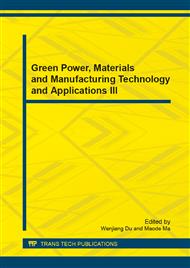[1]
Tobias. D., & Mendelsohn, R (1991) Valuing Ecotourism in a Tropical Rain Forest Reserve. Ambo 1(2): 91-93.
Google Scholar
[2]
Menthes, S., & Lobber, D. J (1996) International Ecotourism and the Valuation of Tropical Rainforests in Costa Rica. Journal of Environmental Management 2(1): 1-10.
Google Scholar
[3]
Tisdell, C., & Wen, J. (1997). Total Economic Evaluation of Protected Areas. Annals of Tourism Research 3(4): 992-994.
DOI: 10.1016/s0160-7383(97)00042-x
Google Scholar
[4]
Lee, C. -K., Lee, J -L., & Han, S. -Y (2000) Measuring the Economic Value of Ecotourism Resources: The Case of South Korea. Journal of Travel Research 4(6): 40-46.
DOI: 10.1177/004728759803600405
Google Scholar
[5]
Freeman(1993) M the Measurement of Environmental and Resources Value: Theory and Methods Washington, RFF 5(6): 957-959.
Google Scholar
[6]
Krutilla J V (1998) Conservation Reconsidered Smith V K. Environmental Resources and Applied Welfare Economics: Cusses in Honor of John V. Drusilla Washington RFF 6(7): 263-273.
Google Scholar
[7]
Wilman E A (1980) The Value of Time in Recreation Benefits Studies Journal Environmental Economics and Management 7(6): 277-283.
Google Scholar
[8]
McConnell K E, Standard I E (1981) Measuring the Cost of Time in Recreation Demand Analysis American Journal of Agricultural Economics 8(9): 6514-6516.
Google Scholar
[9]
Smith V K, Desvousages WH, McGivney M P(1983) The Opportunity Cost of Time in Recreation Demand Model Land Economics 9(5): 314-318.
Google Scholar
[10]
Backstage N E, Strand I E, Hahnemann W H(1987) Time and the Recreation Demand Model American Journal of Agricultural Economics 10(5): 293-302.
Google Scholar
[11]
Rakish Palatal, Gijon Anna Geevarghese, Ram Badu P, et al (1999) Valuation of Landmass Degradation Using Fuzzy Hedonic Method: A Case Study of National Capital Region Environment and Resource Economics 11(4): 519-543.
Google Scholar
[12]
Smith V K(1997) Time and the Valuation of Environmental Resources (Discussion paper 98-107) Washington: RFF 12(4): 122-125.
Google Scholar
[13]
Tyrvainen L, Vaananen H (1998) The Economic Value of Urban Forest Amenities: An Application of Contingent Valuation Method Landscape and Urban Planning 3(5): 557-569.
DOI: 10.1016/s0169-2046(98)00103-0
Google Scholar
[14]
Randall A (1998) Beyond the Crucial Experiment: Mapping the Performance Characteristics of Contingent Valuation Resource and Energy Economics 14(4): 197-206.
DOI: 10.1016/s0928-7655(97)00036-5
Google Scholar
[15]
Gan J, Miller J H, Hargrove T M, et al (1998) Effects of Site Preparation on Timber and Non-Timber Values of Loblolly Pine Plantations Forest Ecology and Management 15(6): 47-53.
DOI: 10.1016/s0378-1127(97)00321-6
Google Scholar
[16]
Schulze W D, Mcglelland G H, Lazo J K, et al (1998) Embedding and Calibration in Measuring Non-use Values Resource and Energy Economics 16(7): 163-178.
DOI: 10.1016/s0928-7655(97)00034-1
Google Scholar
[17]
Green D, Jacowitz K E, Kahneman D, et al(1998) Referendum Contingent Valuation, Anchoring, and Willing to Pay for Public Goods 17(6): 942-946.
DOI: 10.1016/s0928-7655(97)00031-6
Google Scholar
[18]
Blomquist G C, Whitehead J C (1998) Resource Quality Information and Validity of Willingness to Pay in Contingent Resource and Energy Economics 8(9): 514-516.
DOI: 10.1016/s0928-7655(97)00035-3
Google Scholar
[19]
Jianqiang Zheng, Sen Li, Yaoli Huang (2003) Study on the Significance and Tactics of the Exploitation of Desert-tourism Resources in Western Development Areal Research and Development 19(5): 1314-1318.
Google Scholar
[20]
William E. ham mitt, David N. Cole (2011) Recreation Ecology Beijing: Science Ecology 20(6): 757-759.
Google Scholar
[21]
Li Ding, Jiang Jing (2012) Global green new deal and Chinese green economy based on environment and energy materials. Applied Mechanics and Materials 485: 494-501.
DOI: 10.4028/www.scientific.net/amr.485.494
Google Scholar
[22]
Kuo Chil-Chyuan Lin Zhiyang, Tsai Wanglin (2012) A new environment friendly process for making green epoxy-based composites mold. Advanced Materials Research 341: 194-198.
DOI: 10.4028/www.scientific.net/amr.341-342.194
Google Scholar


